Vessels - Classical antiquity - Middle East - Sold antiquities
Archive of sold antiquities
All artefacts sold in our gallery are fully documented in our online archive and database. Being a specialist ancient art dealer, preserving also the more recent history of each and every piece sold in our shop is at our heart. That is particularly useful for artefacts that changed owners in the meantime. Information that may have been lost in the process can be easily restored from our archives. Please do not hesitate to contact us if you need further information about ancient items that have been sold in our gallery. We can help you with reconstructing the history of ownership for those items. All information about our customers will be kept confidential, of course.-
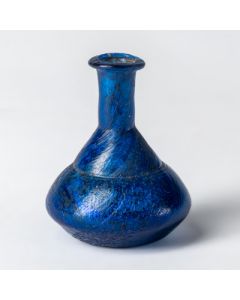 Roman ointment bottle of bright blue glass
Roman ointment bottle of bright blue glassA strikingly colourful bottle for oil or perfume. From the Roman Imperial period, made in a province of the eastern Mediterranean.
Price: on request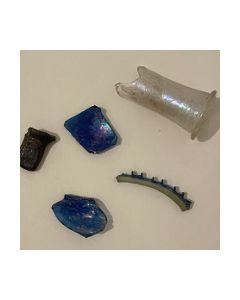 Ancient glass fragments
Ancient glass fragmentsRoman glass shards from the 1st to 4th centuries. Professor Manegold Collection.
Price: on request Roman square glass bottle
Roman square glass bottleTypical and popular glass vessel type from the Roman Imperial period. From the Heckmann collection.
Price: on request Roman glass bowl
Roman glass bowlSmall bowl made of pale turquoise glass, from the Roman Imperial period. Acquired in 1974 at the antiquities gallery Neuhaus.
Price: on request Three ancient pottery vessels
Three ancient pottery vesselsAn exciting mixed group from the Iron Age to Classical Antiquity. From the collection of Professor Manegold.
Price: on request Roman glass bowl
Roman glass bowlSmall bowl made of pale turquoise glass, from the Roman Imperial period. From the Heckmann collection.
Price: on request Roman glass jug with handle
Roman glass jug with handleA fine glass vessel from the 1st to 2nd century. Made in the eastern Mediterranean.
Price: on request Roman globular glass bottle
Roman globular glass bottleBeautifully decorated with bands of incised decorative grooves. Spherical body and funnel-shaped neck.
Price: on request Roman glass bowl
Roman glass bowlThe nice and small bowl is made of thick-walled glass. Possibly an Eastern Mediterranean made vessel.
Price: on request Roman glass flask
Roman glass flaskThe large ancient glass, a so-called unguentarium for perfume or precious oil, comes from the eastern Mediterranean, probably from Syria. Acquired in 1974 from art dealer Albrecht Neuhaus.
Price: on request Roman blue glass bowl
Roman blue glass bowlThe small storage vessel impresses with its beautiful cobalt blue colour. It was made in the 1st century, probably in Italy.
Price: on request Roman sprinkler
Roman sprinklerPerfume bottle with pattern-blown body. An aperture made it easy to dispense the precious content drop by drop. Made in the Roman province Syria in the 3rd cent. AD.
Price: on request Two Roman glass unguentaria
Two Roman glass unguentariaThe early imperial perfume bottles are from the eastern Mediterranean. Acquired in 1974 from art dealer Albrecht Neuhaus.
Price: on request Roman ribbed glass bowl
Roman ribbed glass bowlOf beautiful, thick-walled glass of a bright light green color. The glass was mold made in a Roman factory of the eastern Mediterranean.
Price: on request Roman jug made of aubergine glass
Roman jug made of aubergine glassBeautiful glass with a violet colour. From the Roman Imperial period.
Price: on request Roman glass beaker
Roman glass beakerRare cup made of almost colourless glass. A 4th century product from the eastern Mediterranean.
Price: on request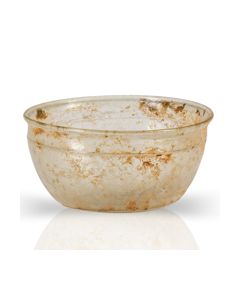 Small Roman glass bowl
Small Roman glass bowlSmall bowl made of colourless glass, from the Roman Imperial period. The shape imitates metal vessels.
Price: on request Roman glass bottle with handle
Roman glass bottle with handleThe cylindrical vessel has a nice iridescent patina. Made between 50 and 200 AD on the Black Sea coast or in the Near East.
Price: on request Roman glass juglet
Roman glass jugletThe small jug with a pear-shaped body is outstanding due to the strongly iridescent patina and the dark coating on the outside. From the Late Roman Imperial period.
Price: on request Roman lentoid glass flask
Roman lentoid glass flaskThe flat bottle has a discoid body with a very long neck. Probably from the Roman province Judaea.
Price: on request Roman glass bottle with handle
Roman glass bottle with handleNice and relatively large bottle from the late Roman imperial period. Probably from the Roman province Judaea.
Price: on request Roman lentoid glass flask
Roman lentoid glass flaskThe flat bottle has a lentoid or discoid body with a long neck. Probably from the Roman province Judaea.
Price: on request Very rare Roman bronze Amor Balsamarium found at Baalbek
Very rare Roman bronze Amor Balsamarium found at BaalbekFrom the collection of Joan Conway Crancer, Honorary Trustee of the Saint Louis Art Museum. Extraordinary preserved for an ancient bronze figure of this size, incl. the original lid. Acquired 1988 in London for 8,500 US Dollar.
Price: on request Roman double head flask with Medusa
Roman double head flask with MedusaTypical head vessel from the Eastern Mediterranean. The glass flask has the shape of two Medusa heads back to back.
Price: on request Roman sprinkler
Roman sprinklerPerfume bottle with pattern-blown body. An aperture made it easy to dispense the precious content drop by drop. Made in the Roman province Syria in the 3rd cent. AD.
Price: on request Roman sprinkler
Roman sprinklerPerfume bottle with pattern-blown body. An aperture made it easy to dispense the precious content drop by drop. From the Late Roman period.
Price: on request Roman sprinkler
Roman sprinklerPerfume bottle with pattern on mold-blown body. An aperture made it easy to dispense the precious content drop by drop. Made in the Roman province Syria in the 3rd to 4th cent. AD.
Price: on request Cypriot bowl
Cypriot bowlVery nice pottery plate painted with circles and accentuations. Cypro-Archaic period.
Price: on request
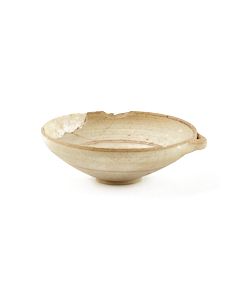 Cypriot bowl
Cypriot bowlThe bowl or dish is decorated with painted circles and a spiral. Cypro-Archaic period.
Price: on request Cypriot stemmed bowl
Cypriot stemmed bowlNice small vessel with well-preserved painted decorations. From Cyprus towards the end of the geometric period and the beginning of the archaic period.
Price: on request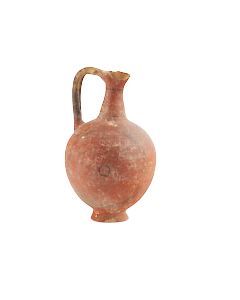 Cypriot oinochoe
Cypriot oinochoeNice orange jug with geometrical decorations. From the cypro-archaic period.
Price: on request Roman double head flask
Roman double head flaskRare type of a head vessel with faces of a young man or boy. Gorgeous blue pigmented glass.
Price: on request Sidonian perfume bottle
Sidonian perfume bottleGlass from Sidon with a decorative relief of amphorae and other vessels. A phoenician production from the 1st century AD.
Price: on request Roman ribbed glass flask
Roman ribbed glass flaskFantastic and rare type of vessel from the Roman provinces of the Levant. Ex professor Ritschel collection.
Price: on request Roman cooking pot of the Herodian type
Roman cooking pot of the Herodian typeLarge vessel from Roman Imperial times. Most finds are known from the Roman province Iudaea.
Price: on request

